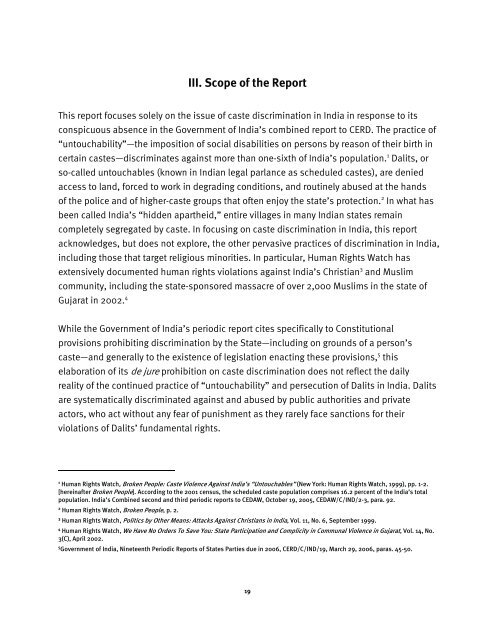Caste Discrimination against India's âUntouchablesâ - Human Rights ...
Caste Discrimination against India's âUntouchablesâ - Human Rights ...
Caste Discrimination against India's âUntouchablesâ - Human Rights ...
Create successful ePaper yourself
Turn your PDF publications into a flip-book with our unique Google optimized e-Paper software.
III. Scope of the Report<br />
This report focuses solely on the issue of caste discrimination in India in response to its<br />
conspicuous absence in the Government of India’s combined report to CERD. The practice of<br />
“untouchability”—the imposition of social disabilities on persons by reason of their birth in<br />
certain castes—discriminates <strong>against</strong> more than one-sixth of India’s population. 1 Dalits, or<br />
so-called untouchables (known in Indian legal parlance as scheduled castes), are denied<br />
access to land, forced to work in degrading conditions, and routinely abused at the hands<br />
of the police and of higher-caste groups that often enjoy the state’s protection. 2 In what has<br />
been called India’s “hidden apartheid,” entire villages in many Indian states remain<br />
completely segregated by caste. In focusing on caste discrimination in India, this report<br />
acknowledges, but does not explore, the other pervasive practices of discrimination in India,<br />
including those that target religious minorities. In particular, <strong>Human</strong> <strong>Rights</strong> Watch has<br />
extensively documented human rights violations <strong>against</strong> India’s Christian 3 and Muslim<br />
community, including the state-sponsored massacre of over 2,000 Muslims in the state of<br />
Gujarat in 2002. 4<br />
While the Government of India’s periodic report cites specifically to Constitutional<br />
provisions prohibiting discrimination by the State—including on grounds of a person’s<br />
caste—and generally to the existence of legislation enacting these provisions, 5 this<br />
elaboration of its de jure prohibition on caste discrimination does not reflect the daily<br />
reality of the continued practice of “untouchability” and persecution of Dalits in India. Dalits<br />
are systematically discriminated <strong>against</strong> and abused by public authorities and private<br />
actors, who act without any fear of punishment as they rarely face sanctions for their<br />
violations of Dalits’ fundamental rights.<br />
1<br />
<strong>Human</strong> <strong>Rights</strong> Watch, Broken People: <strong>Caste</strong> Violence Against India’s “Untouchables” (New York: <strong>Human</strong> <strong>Rights</strong> Watch, 1999), pp. 1-2.<br />
[hereinafter Broken People]. According to the 2001 census, the scheduled caste population comprises 16.2 percent of the India’s total<br />
population. India’s Combined second and third periodic reports to CEDAW, October 19, 2005, CEDAW/C/IND/2-3, para. 92.<br />
2<br />
<strong>Human</strong> <strong>Rights</strong> Watch, Broken People, p. 2.<br />
3<br />
<strong>Human</strong> <strong>Rights</strong> Watch, Politics by Other Means: Attacks Against Christians in India, Vol. 11, No. 6, September 1999.<br />
4<br />
<strong>Human</strong> <strong>Rights</strong> Watch, We Have No Orders To Save You: State Participation and Complicity in Communal Violence in Gujarat, Vol. 14, No.<br />
3(C), April 2002.<br />
5 Government of India, Nineteenth Periodic Reports of States Parties due in 2006, CERD/C/IND/19, March 29, 2006, paras. 45-50.<br />
19

















